Surepka
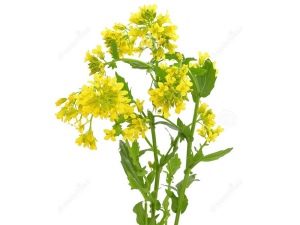
Common colza belongs to the Cabbage family and is a biennial herbaceous plant. It is also commonly called a pea or spring rapeseed.
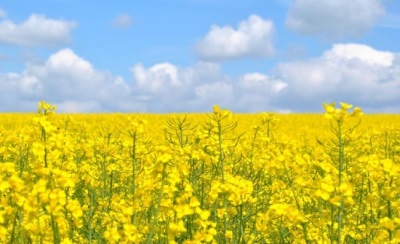
Appearance
This plant is characterized by a rod root system. The stem is erect and bare, and branched at the top. The plant reaches a height of 35 to 70 cm. The colza has mainly lyre-pinnate leaves, with the exception of the basal and lower leaves. They belong to the petiolate leaves (several lateral oblong and large heart-shaped). The leaves at the top of the stem are sessile, entire, and have serrated margins.
The flowers of the bittercress are yellow, are four-membered in the form of a double perianth. Flowers are collected in a brush and have five stamens. The fruit is presented in the form of a tetrahedral pod, which consists of many brown seeds.
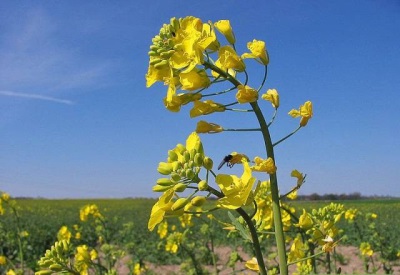
Kinds
Today, science knows up to 20 species of colza, which is found in all corners of the world. In Russia, colza is presented in three types:
- arcuate colza (Barbarea arcuata);
- common colza (Barbarea vilgaris);
- colza pressed or straight (Barbarea stricta).
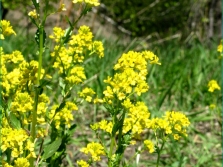
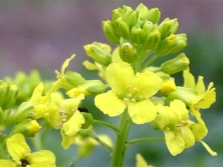
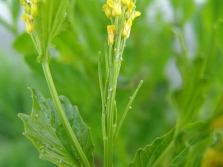
Where does it grow?
Common colt can be found in fields, meadows or near roads, because it grows like a weed. It usually grows in moist soils, although it is picky. The plant is distributed on many continents of the world in the temperate zone. In Russia, colza can be found in Western Siberia and in the European part of the country.
Since ancient times, the plant has been bred in China, Afghanistan, Mongolia, Pakistan and Iran.
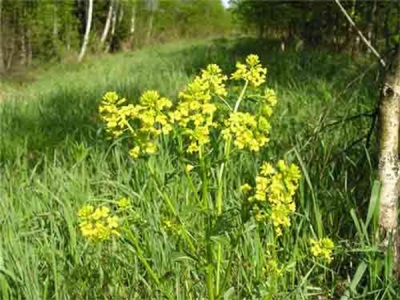
spice making method
- the plant is harvested during the flowering period;
- dry well by spreading it on paper in a room with good ventilation;
- store up to one year in cotton bags.
In the form of a spice, colza has a peculiar taste, with a slight bitterness. Therefore, it should not be abused. It is necessary to add it to the salad according to individual taste preferences. The spice does not have a strong odor, it smells like an ordinary herb.
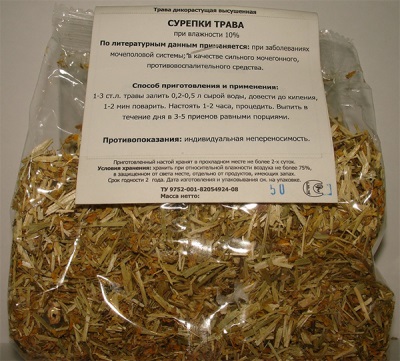
Characteristics
- the plant is an excellent honey plant, because its productivity is up to 50 kg per 1 hectare;
- picky;
- blooms from May to July;
- fruits ripen only in August and September;
- the leaves of the plant taste like mustard;
- greens scalded with boiling water - soft and tasty.
Colza honey has a greenish-yellow color and a pleasant taste. It is used to feed bee colonies.
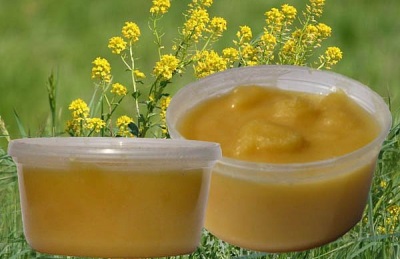
Chemical composition
Unfortunately, today the full composition of the plant has not been studied, but it has already been proven that common colza consists of:
- fatty oil, which is contained in the seeds (36%);
- flavonoids in the aerial parts (5.4%);
- mustard oil;
- glycosides of different types;
- saponins;
- thioglycosides;
- organic acids in leaves;
- ascorbic acid;
- B group vitamins.
Thioglycosides can cause intestinal upset or enteritis. The most toxic are the seeds, because they accumulate a huge amount of toxins. Usually animals suffer from colza. If you give them a lot of fresh grass, poisoning is possible as a result.
Oil
The composition of the fatty oil of rapeseed includes the following acids:
- linolenic;
- linoleic;
- oleic;
- stearic;
- palmitic.
Rapeseed oil is rich in essential omega-3 fatty acids, but unrefined oil contains little-studied erucic acid. Therefore, only refined oil is used in cooking, in which the content of erucic acid is strictly regulated. Rape oil is very useful for people suffering from atherosclerosis, it helps to fight "bad" cholesterol.
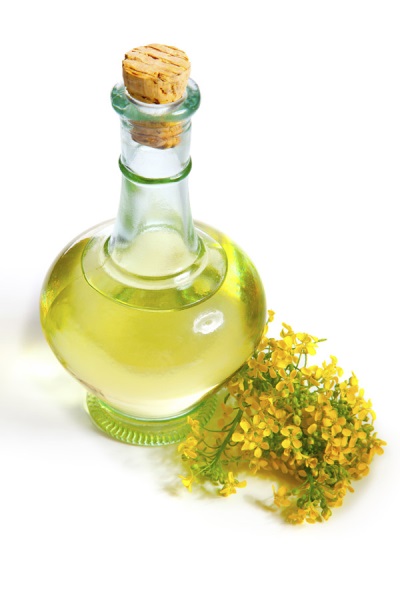
Beneficial features
- the roots have a diuretic effect;
- the seeds are used for a laxative effect;
- leaves have wound healing and anti-inflammatory properties;
- the plant has a mild effect on the composition of the blood and the protective functions of the whole organism.
You can learn more information about colza from the video of the TV show "1000 and one spice of Scheherazade".
Harm
- colza seeds are poisonous to animals, so they should not be used to feed pets and birds;
- you should carefully use the plant for food, because in large quantities, colza can lead to poisoning of the body.
Contraindications
- with increased bleeding;
- in the presence of stones in the bladder or kidneys;
- with inflammatory bowel processes;
- with stomach ulcers.
It can be used by everyone, even children. People who have the above problems can also take the plant for healing, but only in reasonable measures.
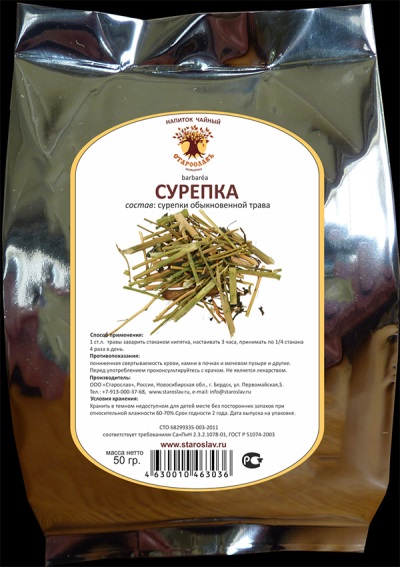
Juice
In folk medicine, colza juice is used to treat paralysis, kidney disease, apoplexy and epilepsy. Freshly squeezed juice helps men with insufficient sperm production.
The juice is used for healing, regeneration of skin cells, and also disinfects tissues and resists their infection.A solution of juice with water is used to wash wounds, including purulent ones, because colza accelerates their healing.
Fresh grass juice can be obtained using a meat grinder. The crushed mass should be squeezed out through medical gauze. You can also use a juicer to extract juice.
Juice can be taken 4 times a day for 30 ml for the treatment of many diseases.
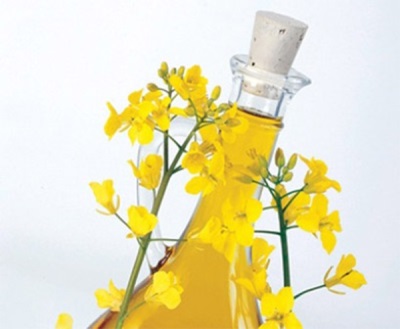
Application
In cooking
- garnishes, mashed potatoes and soups are prepared from colza greens;
- young leaves are used as a spice or used for salads;
- yellow oil, which is obtained from seeds, is used to make pastry in bakery and confectionery products;
- Young colza leaves can be used boiled or raw.
For culinary purposes, unblown inflorescences and young leaves of the plant are mainly used. After heat treatment, the plant loses its bitterness, and in taste it is similar to cabbage, so it is widely used in soups. It is worth paying attention that you need to cook colza for no more than three minutes so that it does not lose its taste. Blooms can be baked in batter.
The plant is especially popular in cooking in Canada and America.

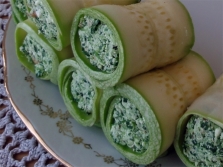
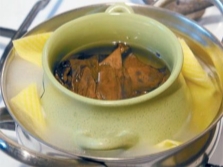
spring rapeseed salad recipe
- green onions;
- colza leaves;
- boiled egg;
- sour cream or mayonnaise for dressing.
You need to take green onions and colza leaves in equal proportions, finely chop and add the egg. Then salt to taste and dress the salad with mayonnaise or sour cream. Salad ready.
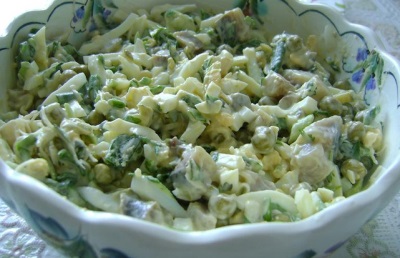
In medicine
- tones the activity of the entire human body;
- has a diuretic effect on the body;
- helps to heal wounds;
- increases appetite;
- fights chronic constipation;
- with paralysis or dropsy;
- increases oxygen saturation of brain tissues;
- used as an antiscorbutic;
- increases sexual activity decoction of the seeds or roots of the plant;
- with general weakness of the body and fatigue, tea is prepared from the grass;
- with nervous disorders;
- restores the body after a stroke or heart attack;
- improves sleep.
For medicinal purposes, only the ground part of the colza is used, because its leaves contain a lot of ascorbic acid, and the seeds contain a lot of thioglycosides.
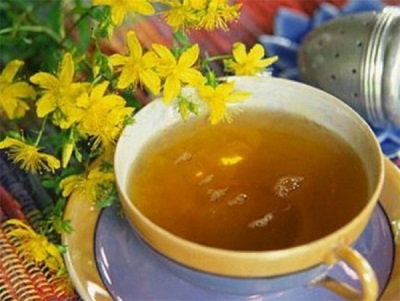
Dry colza tincture recipes
First option:
- 20 grams of a plant;
- 200 grams of water.
It is necessary to bring the water to a boil and pour it over the grass, then wait three hours and strain the tincture through a strainer. It should be consumed 4 times a day, 400 grams each, to forget about edema, strengthen the body and improve your health.
Second option:
- 40 grams of grass;
- 200 grams of water.
You need to pour hot water over the herb, wait three hours and strain the tincture before drinking. It is recommended to take 50 ml of tincture 4 times a day after meals to get rid of edema. This recipe is suitable for the treatment of hypovitaminosis and paralysis.
At home
Used in everyday life:
- for decorative purposes, because the plant has a beautiful appearance;
- the fatty oil of the plant is used in the manufacture of soap;
- from the yellow flowers of the colza, a natural dye is made, which is used to dye fabrics, for example, for silk.
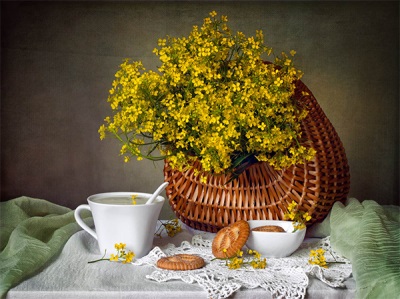
Varieties
In floriculture, different forms of common colza are used for decoration:
- Barbarea vulgaris arcuata;
- Barbarea vulgaris "Flore Pleno";
- Barbarea vulgaris var. hirsuta (Herb-Barbaras);
- Barbarea vulgaris "Variegata";
- Barbarea vulgaris "Variegated Winter";
- Barbarea vulgaris Variegated Winter Cream.
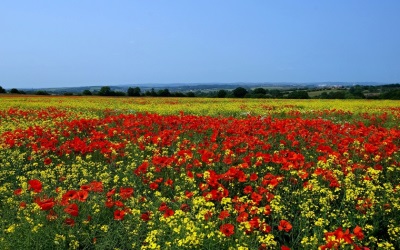
cultivation
The turnip is a weed plant, so it does not require special costs when growing.It grows well on wet soils, in fields and meadows, near water bodies. It can be found in open areas with sparse vegetation.
It is necessary to make harvesting of colza during the flowering period. Stems, flowers, leaves and young pods are collected.


















We have a lot of colza in the country. How useful it turns out to be!